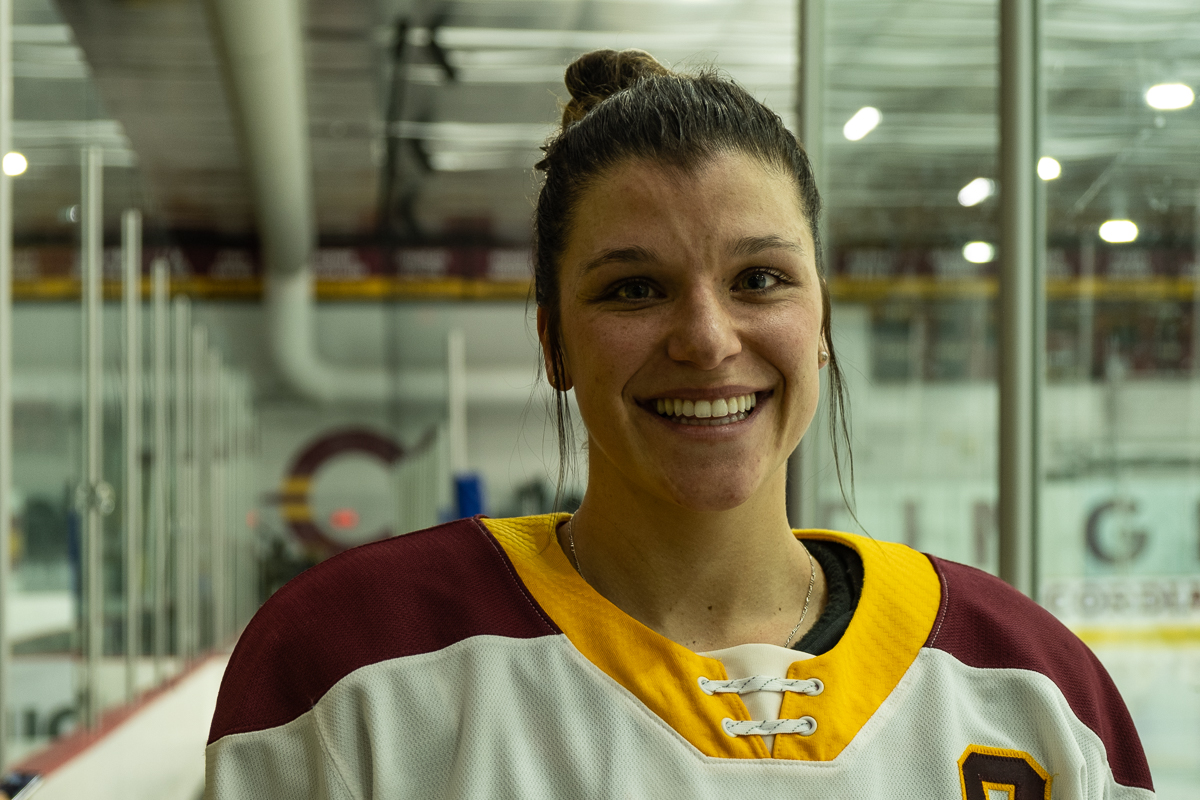The captain of the Stingers female hockey team looks back on her university career and what to expect in her final season
As her custom Concordia maroon and yellow painted skates touch the ice, Stingers captain Audrey Belzile is dialled in. From warmups to the start of the national anthem, no one can deter her from playing her game. A mix of physicality and finesse, aggressive forechecking and backchecking, Belzile is a leader that demonstrates on a nightly basis to the rest of the team how to be an all-around contributor.
Growing up in Saint-Hyacinthe, Quebec, Belzile’s affinity for hockey was passed down by her mother. With hockey clearly in the family lineage, Belzile received her first pair of skates from her mom at five years old. Every opportunity she had to hop on the ice blossomed her love for skating.
“Every time we went outside during the winter, I always wanted to continue skating. I liked it so much she registered me for hockey.”
Belzile eventually grew into an effective player all throughout the amateur level. Her consistency secured a position playing for the Cégep St-Laurent Patriotes, where she broke out as a player, tallying 59 points in 39 games. Her two seasons playing there garnered the attention of high-level American colleges, providing the next step in Belzile’s career.
Teams from Yale, Clarkson, and Maine were all interested in Belzile, but language was the ultimate deterrent from attaining her goal. Choosing Boston University as her preferred team, the university recommended that Belzile undergo an English exam to be granted a scholarship. The minimum grade to be accepted was 80 per cent — Belzile scored 76 per cent. Boston University recommended that Belzile return to CEGEP to practice her English and retake the test the year after in order to be eligible.
“If you don’t succeed in class, for them it’s a loss of money,” Belzile said. “Admissions didn’t feel comfortable in giving a full scholarship.”
The increased level of competition in female hockey in Quebec influenced Belzile to return and play at a university level in the province. Many players from Quebec decide to play for domestic universities, upping the level of hockey comparable to the NCAA.
“The teams are super good now because lots of girls decided to stay in Quebec,” Belzile said.
Visiting both McGill and Concordia, she ultimately chose the Stingers. “I chose Concordia not only for the coaching staff, but because when I came on the team, the girls made it feel like I was already a part of the team.”
In Belzile’s five seasons, the Stingers have had great success, usually finishing as a top team in the regular season. She can’t credit the coaching staff enough, for not only her growth as a hockey player, but also for the invaluable knowledge of the game that they passed onto her . This season, Belzile and the team are trying to relive what they experienced in 2017–18, winning the RSEQ Championship and bronze in the U SPORTS Championship.
The COVID-19 pandemic not only robbed Belzile of her final year with the Stingers but also her chance at captaincy, and another shot at the championship.
“I was just not ready to close the chapter of my life in hockey when I didn’t know it was the end. I didn’t know that I played my last game, I didn’t know that it was my last year.”
She missed the daily morning practices with teammates and the whole routine of it all. The sudden unexpectedness of not being able to play made Belzile want to get on the ice that much more.
Luckily for Belzile, one year of eligibility was granted by the RSEQ, allowing fifth-year players the chance of returning for their final season.
“I was supposed to be done in the COVID year, but because we could come back, I added another minor this year in political science.”
Many of her other fifth-year teammates decided to also play through their extra year of eligibility. Belzile described her five years with the team as one big family and was not yet prepared to move on. Hesitant at first, they all decided to return for their last season playing altogether.
“When we all said to each other that we all wanted to come back, it just clarified things and made us say okay let’s go for one last ride and try to win it.”
In the past, Belzile claimed that a major obstacle for the team’s success was envisioning the goal instead of concentrating on the present. She highlighted that the key to success this season is taking things one game at a time and avoiding looking too much into the future. Belzile can’t stress enough that this is a very talented team, and they have a great opportunity of going far this year.
Though Belzile once dreamt of playing hockey professionally, she’d rather concentrate on pursuing a career in management than juggling a schedule of games and practices.
A graduate of international business with a minor in entrepreneurship, Belzile hopes to apply some of what she has learned as a captain in her future job hoping to work with an international company in management. Transitioning from sports to business, she’s adamant on putting the same level of determination that she has had in hockey for so long, in pursuing a successful career beyond it.
Photograph by Kaitlynn Rodney
